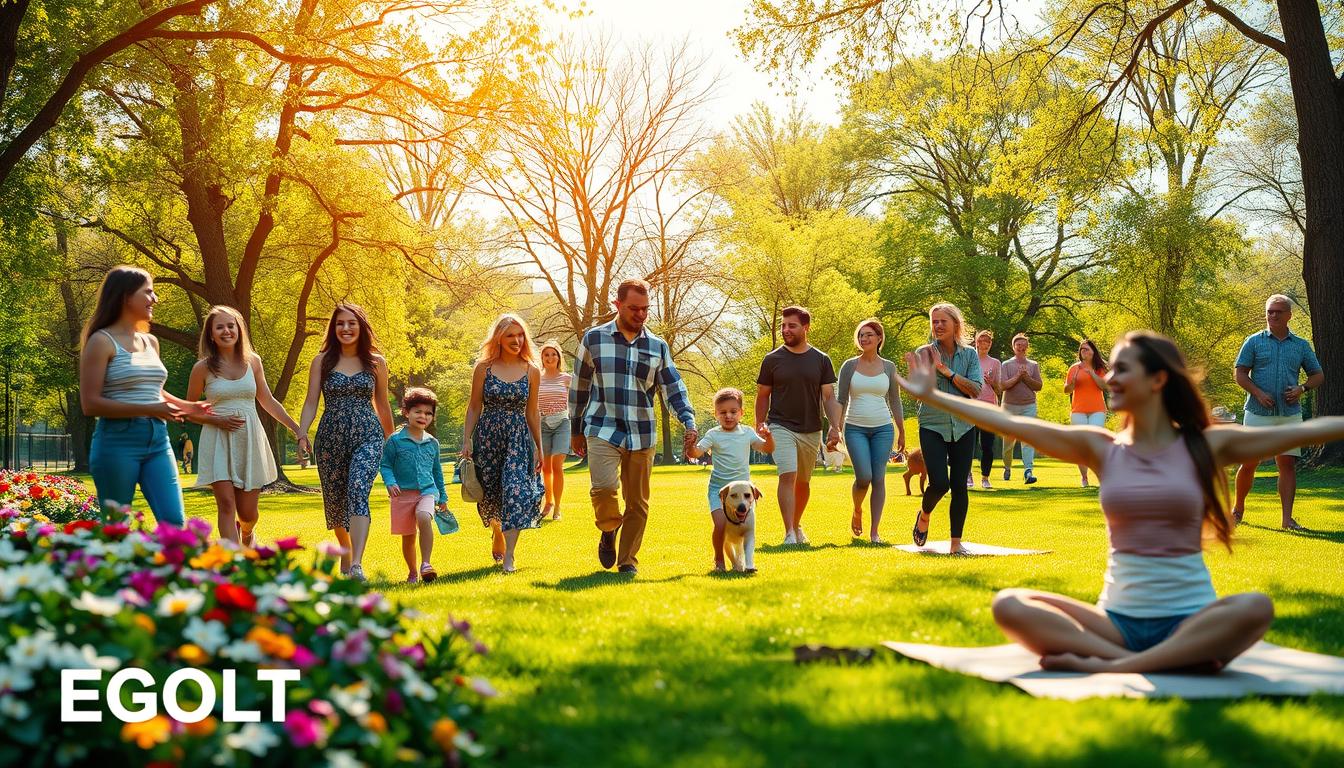Understanding the habits of happy people is key to happiness and fulfillment. This article explores the science-backed strategies and daily routines of those who are joyful. It offers a roadmap to a more positive and purposeful life.

We’ll look at the connection between self-improvement, positive psychology, and personal growth strategies. We’ll discover the secrets to living your best life. Topics include brain chemistry, mindfulness, and gratitude. This guide will give you the tools for self-discovery and personal transformation.
If you want to boost your well-being, strengthen relationships, or find more purpose, this article has you covered. It provides a blueprint for a fulfilling and joyful life.
Understanding the Science Behind Happiness and Well-being
Happiness and well-being are things everyone wants. Science has made big discoveries about how we feel good. It’s all about brain chemistry, the good stuff from positive psychology, and how happiness helps our bodies.
The Role of Brain Chemistry in Happiness
Chemicals like serotonin and dopamine control our mood and feelings. When they’re balanced, we feel happy and content. But, if they’re off, we might feel sad or anxious. This shows how important brain chemistry is for our emotional well-being.
Research-Backed Benefits of Positive Psychology
Positive psychology has changed how we see happiness. It shows that feeling good, being strong, and finding purpose can make us happier. It also makes us healthier in body and mind.
How Happiness Impacts Physical Health
Happiness is good for our bodies. Happy people have stronger immune systems and live longer. Happiness helps us stay healthy by making us less stressed and helping our bodies heal.

| Neurotransmitter | Role in Happiness |
|---|---|
| Serotonin | Regulates mood, sleep, and appetite |
| Dopamine | Fuels feelings of reward, motivation, and pleasure |
| Oxytocin | Fosters social bonding and trust |
| Endorphins | Reduces pain and triggers feelings of euphoria |
Mindfulness and Present Moment Awareness
Living our best lives means using mindfulness and being present. Mindfulness, like meditation and deep breathing, helps us feel less stressed and more focused. It also boosts our emotional well-being and joy.
By focusing on the now, we escape endless worries. Mindfulness lets us enjoy life’s small joys. It helps us deal with problems more clearly and with kindness.
- Mindfulness meditation: Cultivating the ability to be fully present and attentive to the current moment, without judgment or attachment.
- Deep breathing exercises: Utilizing the power of the breath to calm the mind and body, reducing stress and promoting a sense of inner peace.
- Body scans: Mindfully exploring and acknowledging the sensations throughout the body, fostering a deeper connection with the physical self.
Adding mindfulness practices to our daily routine changes our lives. It improves our emotional well-being and helps us find joy. Being present brings us clarity, focus, and happiness.

How to Live Your Best Life: Habits of Happy People
Building healthy lifestyle habits is key to feeling good and being happy. By starting with good morning routines, ending with calming evening practices, and adding weekly rituals, you can find joy and fulfillment.
Morning Routines of Happy Individuals
Happy people often begin their day with habits that make them feel good. These habits include:
- Practicing mindfulness or meditation
- Eating a healthy breakfast
- Learning something new or writing in a journal
- Doing some exercise
- Being thankful and positive
Evening Practices for Emotional Balance
Evening rituals can help you feel calm and ready for sleep. They include:
- Using relaxation techniques like deep breathing or yoga
- Turning off screens to avoid stress
- Thinking about the day’s good moments and being thankful
- Doing something relaxing, like reading or listening to music
- Getting a good night’s sleep
Weekly Habits That Boost Life Satisfaction
Weekly habits can also make you happier. These might be:
| Habit | Benefit |
|---|---|
| Spending time in nature | Reduces stress and improves focus |
| Doing something creative | Brings joy and a sense of achievement |
| Connecting with family and friends | Strengthens relationships |
| Helping others | Gives a sense of purpose |
By adding these healthy lifestyle habits to your life, you can improve your emotional well-being and happiness.
Cultivating Meaningful Relationships
Building strong relationships is key to personal growth and feeling good. These connections add joy to our lives and give us a sense of purpose. By focusing on joy in our relationships, we can grow and be happier.
To build meaningful relationships, we need to be intentional, empathetic, and genuine. It’s not just about having many friends, but about the quality of our interactions. Here are some tips to help you build strong relationships:
- Prioritize quality time – Make time for friends, family, and loved ones without distractions. Listen fully and be there in the moment.
- Practice active listening – When talking to others, try to understand their point of view and needs. Don’t just wait to speak.
- Be vulnerable and authentic – Share your true thoughts and feelings. This can help build trust and deeper connections.
- Offer support and empathy – Be there for your loved ones when they need you. Listen and help when you can.
- Celebrate milestones and achievements – Acknowledge and celebrate the successes of those close to you. Show your pride and joy in their achievements.
By using these strategies, you can create a network of meaningful relationships. These relationships will support your personal growth, emotional well-being, and joy.
| Relationship Aspect | Importance for Personal Growth | Strategies for Cultivation |
|---|---|---|
| Quality Time | Fosters deeper connections and understanding | Set aside dedicated time, minimize distractions |
| Active Listening | Promotes empathy and mutual understanding | Focus on comprehending others’ perspectives |
| Vulnerability | Builds trust and intimacy in relationships | Share genuine thoughts, feelings, and experiences |
| Support and Empathy | Strengthens emotional bonds and resilience | Offer assistance and compassion during difficult times |
| Celebration | Reinforces positive emotions and shared joy | Recognize and express happiness for others’ achievements |
The Power of Gratitude Practice
In positive psychology, gratitude is key for finding joy and emotional well-being. It helps us see the good things in our lives. This leads to feeling thankful and happy every day.
Daily Gratitude Exercises
Adding gratitude to our daily life changes us. Just taking a few minutes each morning to think about what we’re thankful for can make a big difference. Or, writing down three good things at night helps us focus on the positive. These habits make us more mindful and grateful, leading to a happier life.
Writing Gratitude Journals
Gratitude journaling is a great way to practice gratitude. It helps us understand what makes us happy. By writing down our thanks, we remember the good things we often miss in our busy lives.
Expressing Thanks to Others
Showing thanks to those who help us is also important. A kind letter, a card, or just saying thanks can make a big difference. It makes our relationships stronger and spreads happiness around us.
Gratitude opens the door to a happier, more fulfilling life. By doing daily exercises, journaling, and showing thanks, we build a mindset of abundance. This is the foundation for living a life full of joy and well-being.
Setting and Achieving Personal Goals
Setting and reaching personal goals is key to self-improvement and living with purpose. By setting clear goals, we find deep fulfillment and make progress. This part talks about how to set goals you can reach and track your success.
Goals and happiness are closely linked. Studies show that chasing our dreams makes us happier and more fulfilled. Setting and achieving goals gives us a sense of purpose and accomplishment.
Crafting Achievable Goals
Creating effective goals is about being specific, measurable, attainable, relevant, and time-bound (S.M.A.R.T.). This approach helps us make a clear plan for success and avoid unrealistic goals.
- Specific: Clearly define your goal, answering who, what, where, when, and why.
- Measurable: Use numbers to track your progress and celebrate your wins.
- Achievable: Make sure your goal is realistic, based on your resources and skills.
- Relevant: Choose goals that match your values and passions.
- Time-Bound: Set a realistic timeline for your goal, with milestones along the way.
Tracking Progress and Celebrating Successes
Reaching goals is just the start. The real challenge is keeping track of your progress and staying motivated. Regular check-ins, self-reflection, and celebrating small victories help keep you on track and motivated.
| Strategies for Tracking Progress | Benefits of Celebrating Successes |
|---|---|
|
|
By focusing on self-improvement, personal growth strategies, and a purpose-driven mindset, we can unlock the power of goal-setting. This leads to a journey of fulfillment and success.
Creating Work-Life Harmony
It’s key to find a balance between work and personal life for emotional well-being and happiness. Setting boundaries, managing time well, and reducing stress help achieve this balance. This way, you can live a life that supports your healthy lifestyle habits.
Establishing Healthy Boundaries
Creating clear lines between work and personal time is essential. This means setting work hours, avoiding work emails outside those hours, and making time for yourself. It’s about making space for fun and self-care.
Time Management Strategies
- Prioritize tasks based on what’s most important and urgent
- Use tools like the Pomodoro method to work more efficiently
- Delegate tasks to have more time for what matters
Stress Reduction Techniques
Stress management is vital for emotional balance. Here are some ways to reduce stress:
- Regular exercise boosts both physical and mental health
- Mindfulness practices like meditation help calm the mind
- Engaging in hobbies brings joy and relaxation
| Healthy Lifestyle Habit | Impact on Emotional Well-being | Contribution to Life Satisfaction |
|---|---|---|
| Establishing Healthy Boundaries | Reduces stress and burnout, promotes work-life balance | Increases overall sense of control and fulfillment |
| Effective Time Management | Enhances productivity and reduces feelings of overwhelm | Allows for more time dedicated to personal pursuits and relationships |
| Stress Reduction Techniques | Improves mood, boosts energy levels, and supports mental health | Fosters a greater sense of well-being and life enjoyment |
By using these strategies, you can achieve a balanced life. This balance supports your healthy lifestyle habits, emotional well-being, and happiness.
Physical Well-being and Exercise Habits
Living a healthy lifestyle is key to a fulfilling life. Exercise boosts our physical health and helps our mental state. Adding regular physical activity to our day can greatly improve our happiness and well-being.
Exercise releases endorphins, which make us feel good and reduce stress. It also helps us sleep better, have more energy, and stay healthy. These benefits lead to a more positive and balanced life.
Incorporating Exercise into Your Routine
Finding an exercise routine you enjoy is crucial. Here are some tips to help you:
- Aim for at least 30 minutes of moderate exercise, such as brisk walking, cycling, or swimming, most days of the week.
- Try to incorporate a variety of activities, including strength training, cardiovascular exercises, and flexibility-focused workouts, to target different aspects of physical fitness.
- Explore new and enjoyable forms of exercise, such as dancing, rock climbing, or hiking, to keep your routine fresh and engaging.
- Set achievable goals and track your progress to stay motivated and celebrate your successes.
Adding exercise to your life can greatly improve your self-improvement and emotional well-being. By focusing on your physical well-being, you’ll live your best life and feel more balanced and fulfilled.
| Exercise Type | Benefits | Recommended Duration |
|---|---|---|
| Aerobic Exercise | Improved cardiovascular health, increased endurance, and better mood | 30-60 minutes, most days of the week |
| Strength Training | Increased muscle strength, improved bone density, and enhanced metabolic function | 2-3 times per week, targeting all major muscle groups |
| Flexibility Exercises | Improved range of motion, reduced risk of injury, and better posture | 10-15 minutes, daily or every other day |
Nurturing Mental Health Daily
Good mental health is key to a happy life. By taking care of yourself, understanding your emotions, and changing your mindset, you can feel better every day.
Self-Care Practices
Self-care is the base of mental health. Do things that make your body, mind, and spirit happy, like:
- Practicing mindfulness through meditation or deep breathing exercises
- Prioritizing quality sleep and creating a relaxing bedtime routine
- Incorporating regular physical activity, whether it’s a leisurely walk or a challenging workout
- Indulging in hobbies and creative pursuits that bring you joy
Emotional Intelligence Development
Emotional intelligence helps you understand and manage your feelings. It boosts your well-being and growth. Try these methods:
- Journaling to gain self-awareness and process your feelings
- Practicing active listening and empathy in your relationships
- Developing stress management strategies, such as positive self-talk or seeking social support
Mindset Transformation Tips
Your mindset affects your happiness and success. Use these tips to change your mindset:
- Reframe negative thoughts into positive, empowering ones
- Foster a growth mindset, embracing challenges as opportunities for learning and growth
- Practice gratitude by acknowledging the blessings and positive aspects of your life
By focusing on self-care, emotional intelligence, and mindset changes, you can find more joy, happiness, and growth in your life.
Living with Purpose and Intention
Living your best life means finding your purpose and living with intention. By choosing actions that match your values, you find true fulfillment. Purpose-driven living helps you make choices that grow you and make you happy.
Finding your life purpose is a big step. It involves thinking about your values, goals, and passions. Knowing your purpose helps you make choices that move you closer to it.
- Think about what matters most to you and what makes you happy.
- Look at your talents and interests. See how you can use them to help others.
- Set goals that match your purpose and track your progress.
Living with intention means creating a life that is both meaningful and satisfying. This might include habits like mindfulness, exercise, and building strong relationships.
| Intentional Living Practices | Benefits |
|---|---|
| Mindfulness meditation | Increased focus, emotional regulation, and overall well-being |
| Regular exercise | Improved physical and mental health, increased energy, and enhanced mood |
| Gratitude journaling | Improved outlook, increased life satisfaction, and stronger relationships |
Choosing purpose-driven living and personal growth strategies leads to happiness and well-being. By living in line with your values and purpose, you create a life that is truly fulfilling.
Building Resilience and Adaptability
In life’s ever-changing world, it’s key to grow resilient and adaptable. This helps with personal growth, emotional health, and self-improvement. By facing challenges head-on and learning from setbacks, we build the strength to thrive in uncertain times.
Overcoming Challenges
Life throws us challenges, but we can turn them into growth chances. Resilient individuals see obstacles as temporary and find ways to move past them. With a problem-solving attitude, self-compassion, and support from others, we can conquer tough challenges.
Learning from Setbacks
Setbacks and failures are part of growing and improving. Adaptable people see these as chances to learn and grow. By learning from mistakes and adjusting our ways, we can turn negatives into positives.
Growing Through Adversity
Adversity can spark personal change and emotional health. Resilient folks use their inner strength to push through tough times. With a growth mindset, mindfulness, and support, we can come out stronger and ready for more challenges.
Building resilience and adaptability is a lifelong journey. Embracing challenges, learning from setbacks, and growing through adversity unlocks our full potential. It boosts our emotional well-being and helps us live our best lives.
Practicing Self-Compassion
Starting your journey to emotional well-being and self-improvement begins with self-compassion. This powerful approach teaches us to be kind to ourselves, just as we are to our loved ones. By embracing our flaws and failures with compassion, we open the door to true happiness and growth.
Self-compassion is about understanding that we all face setbacks and challenges. It’s about treating ourselves with kindness and empathy, rather than harsh judgment. This mindset change can deeply impact our emotional health and personal growth.
Cultivating Self-Compassion
Building self-compassion is a daily practice that can be enhanced through mindfulness. Here are some effective ways to do so:
- Self-kindness exercises: Write yourself a letter of compassion or speak kind words in the mirror.
- Mindful self-awareness: Take moments to notice your thoughts and feelings without judgment.
- Connecting with common humanity: Remember, you’re not alone in your struggles; everyone faces imperfections.
- Gratitude practices: Reflect on your strengths and the positive aspects of your life.
By making these self-compassion practices a part of your daily life, you can develop a deep sense of emotional well-being and self-acceptance. These are key to living your best life.
The Art of Positive Self-Talk
In the world of positive psychology, positive self-talk is incredibly powerful. It can change our mindset, affect our feelings, and help us grow in emotional well-being and self-improvement.
It’s important to notice and change negative thoughts. By replacing harsh inner talks with kinder ones, we build self-compassion, strength, and confidence.
Techniques for Positive Self-Talk
- Identify and challenge negative self-talk: Notice the negative thoughts that pop up. When you catch them, change them to something positive.
- Practice affirmations: Say positive things about yourself, like “I can reach my goals” or “I deserve love and happiness.”
- Engage in self-dialogue: Talk to yourself kindly, just like you would to a friend.
- Visualize success: Picture yourself doing well in tough times or reaching your goals. This helps your mind believe in positive outcomes.
Using these methods daily can greatly improve your emotional well-being and self-improvement. Start practicing positive self-talk and open the door to your best life.
Conclusion
We’ve looked at habits and strategies for a happy life. We’ve learned about the science of well-being and how to be mindful and grateful. We’ve also seen the importance of good relationships.
Unlocking your full potential takes practice and patience. By following the habits we’ve talked about, you can become more positive and purposeful. Remember, your best life is a journey, not a single goal.
Start this journey with an open heart and mind. Face challenges and celebrate small victories. Take care of your mind, body, and spirit to find true happiness. Shape your future with every moment and embrace positive change.



